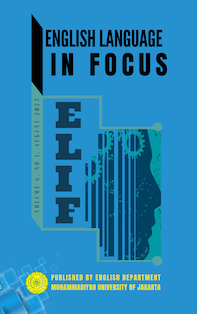Analysis of Teachers-Construct Reading Comprehension Revised Based on Taxonomy Bloom of English Textbook for Junior High School
DOI:
https://doi.org/10.24853/elif.6.1.9-18Abstract
The purpose of this study was to examine the six upper levels of the cognitive domain of Bloom's revised taxonomy used in the textbook titled Bahasa Inggris SMP/MTS Grade 7 Second Semester, namely memory level (C1), comprehension level (C2), Applied Level (C3), Analytical Level (C4), Assessment Level (C5) and Creative Level (C6). Using descriptive qualitative methods and content analysis, this study examined questions in reading comprehension tasks to determine the extent to which reading comprehension questions emphasized higher thinking skills (HOTS) and lower thinking skills (LOTS). The focus of this study is the analysis of the 7th second semester of the Bahasa Inggris SMP/MTS class. The researchers collected and listed questions on the reading comprehension task, then calculated the percentage and frequency of each cognitive level in each individual book chapter and in all four book chapters.Published
2023-07-27
Issue
Section
Articles
License
Authors who publish with this journal agree to the following terms:
- Authors retain copyright and grant the journal right of first publication with the work simultaneously licensed under a Creative Commons Attribution License that allows others to share the work with an acknowledgment of the work's authorship and initial publication in this journal.
- Authors can enter into separate, additional contractual arrangements for the non-exclusive distribution of the journal's published version of the work (e.g., post it to an institutional repository or publish it in a book), with an acknowledgment of its initial publication in this journal.
- Authors are permitted and encouraged to post their work online (e.g., in institutional repositories or on their website) before and during the submission process, as it can lead to productive exchanges, as well as earlier and greater citation of published work (See The Effect of Open Access).


